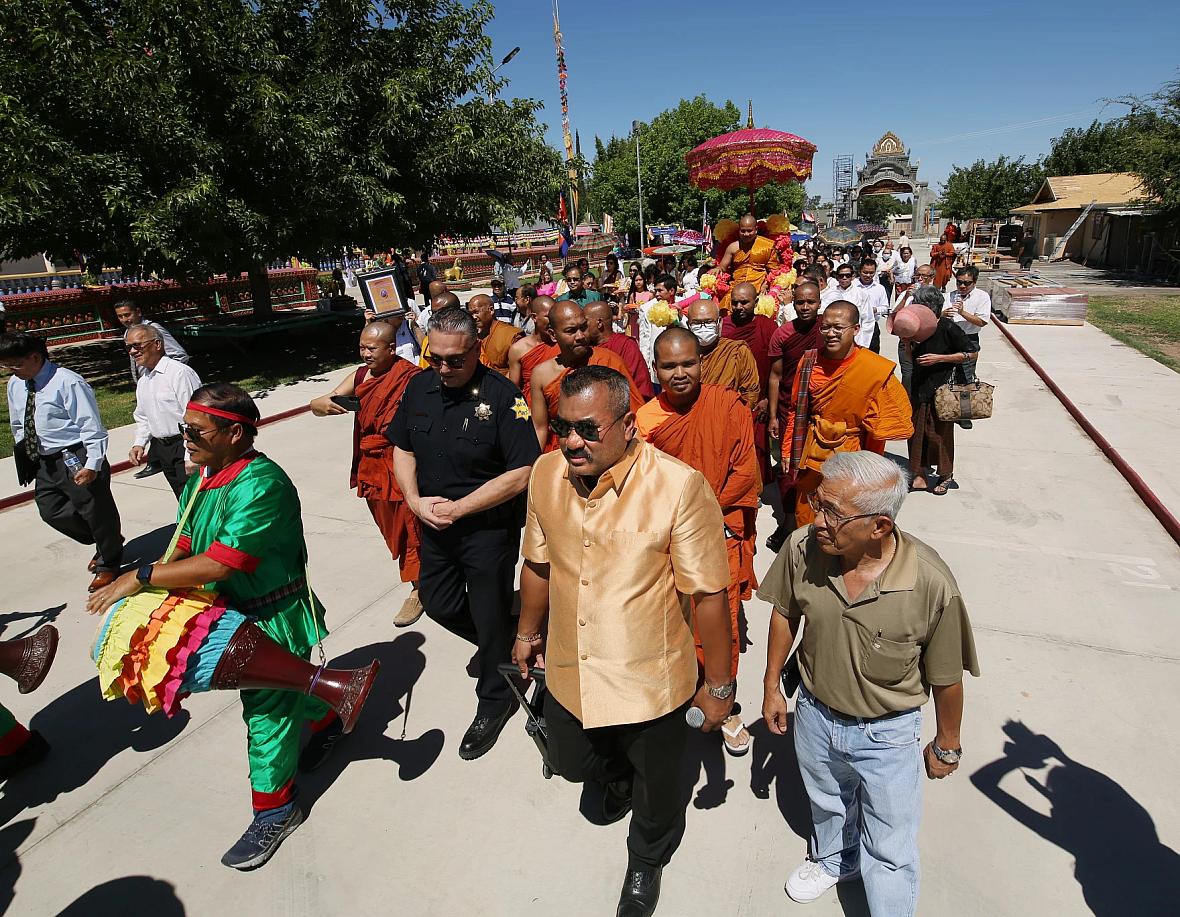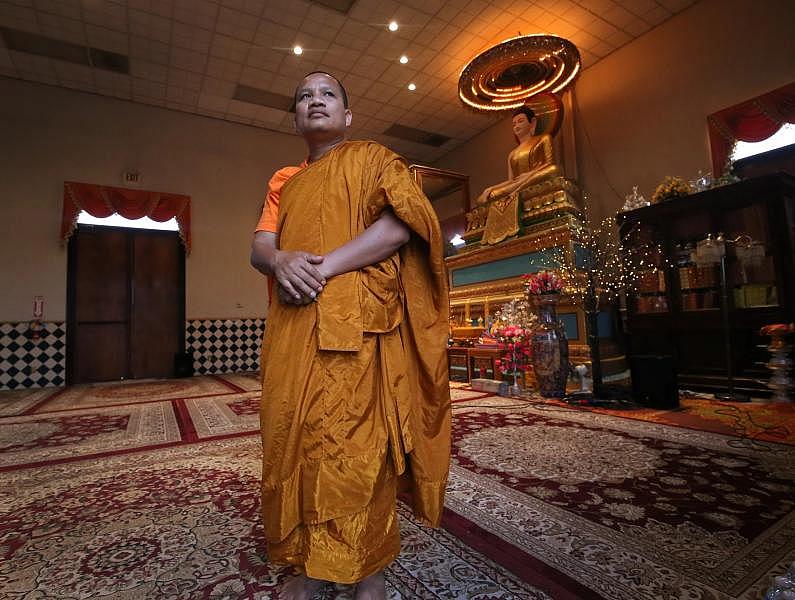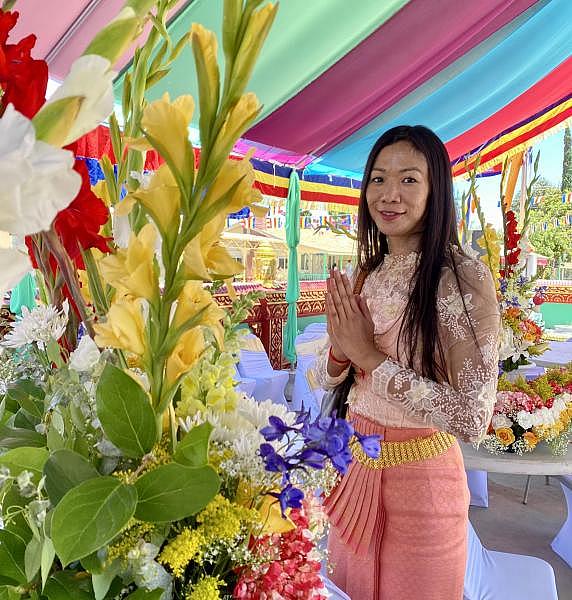How a temple, and a newer generation, is carrying Cambodian tradition in Fresno
This story was originally published in KVPR with support from the 2022 California Fellowship.

Danny Kim walks a parade for the Temple Abbot, Say Bunthon during the Holy Water Blessing ceremony at the Fresno Cambodian Buddhist Temple Saturday, July 2, 2022 in Fresno, Calif.
Gary Kazanjian
CHJ · How A Temple, And A Newer Generation, Is Carrying Cambodian Tradition In Fresno
This story is part of the series Health and Healing for Cambodian Survivors.
FRESNO, Calif. — On a Saturday afternoon the largest Cambodian Buddhist temple in Fresno is alive with color and movement.
Bursts of Cambodian folk music cut through the chatter of volunteers criss-crossing the Budhasasanac Rangsey Temple grounds under the sweltering afternoon sun.
The musicians have taken refuge under the shade to practice for their performance.
In between songs, they watch as workers carry chairs, fabrics, and push carts filled with water bottles – all of it bound for the Holy Water Blessing. It’s part of a special ceremony to inaugurate the new temple abbot, or head monk.

Nancy Meas is preparing bouquets that will be placed on the main stage, where tiered steps lead up to an ornate white and gold throne.
“We're actually going to place them here at the abbot's seating area, so this is his stage,” Meas says.
Meas’s family, like thousands of other Cambodians, fled the 1970s Khmer Rouge genocide. And like her family, some settled in Fresno. Those families now come to this temple to find each other again.
“I feel it's very important to stay involved to preserve our culture because Cambodia is like, nearly, you know, destroyed,” Meas says, her voice trembling.
The day’s Holy Water Blessing is the first at this Fresno Cambodian Buddhist temple. On this day, it is welcoming Say Bunthon, its first dedicated abbot, for a lifelong appointment.
Preparations for the big day go on for months. More than 60 Cambodian monks from all over the country arrive for the inauguration.
“Cambodians in Fresno have never done something like this,” Bunthon says.
A New Generation of Leadership

Originally from Cambodia, Bunthon was educated in Sri Lanka before being sponsored to come to the Fresno temple in 2019. While he is too young to have experienced the genocide, the abbot says he’s come to understand the struggles of those who survived it.
“Cambodians that were forced to escape from the war, especially the parents and grandparents of the previous generation – the ones that came during the 1970s and ‘80s – they all traveled and survived the Khmer Rouge,” he says.
The abbot says his leadership at the temple gives him perspective of the trauma the older generation is carrying.
“The elders that come to the temple, most of them talk about their feelings and emotions regarding the Khmer Rouge that they have experienced. And they often remind themselves of what they have gone through,” he says.
For many in the community, the temple provides a place to heal from the past and Bunthon says everything about the environment at the temple supports community well-being.
“In the back, we have rice paddies, bamboo and banana trees, all those we have in Cambodia and what many Cambodian people also grow around their homes,” he says.
Recreating a sense of home is also the theme behind the Cambodian Night Market, which is held at the temple once a month. It features live music, food and souvenir vendors. The Night Market was launched last year by Danny Kim, a sergeant on the Fresno Police force whose family also survived the genocide and resettled in California.
Kim says Bunthon was a key in helping bring the idea of the Night Market to life at the temple.
“I reached out to him because I know he can convince some of the board, some of the elders in the temple to help make it happen,” Kim says.

The abbot’s leadership is helping to bridge the divide between the older and younger generations of leaders, like Kim, who see opportunities to strengthen Cambodian culture and identity.
“That's why I put 'Cambodian Night Market' because I want the Cambodians to feel proud of this event,” he says.
It’s been a proud day for the temple to host this Holy Water Blessing. As the inauguration is about to start, a procession of temple-goers and musicians form a line. At the head of the group, the abbot is seated atop a brightly colored chariot wrapped in orange and yellow fabric.
The procession begins moving, with the musicians leading the way. They circle around the temple.
Soon, the abbot will take his seat. Kim is also in line. In this moment, both are carrying out ancient traditions, but they are a new generation of Cambodian leaders who are helping build a community in the heart of California.
This is the final part of KVPR’s five-part series, “Health and Healing for Cambodian Survivors.”
This story was produced as a project for the USC Annenberg Center for Health Journalism’s 2022 California Fellowship.


